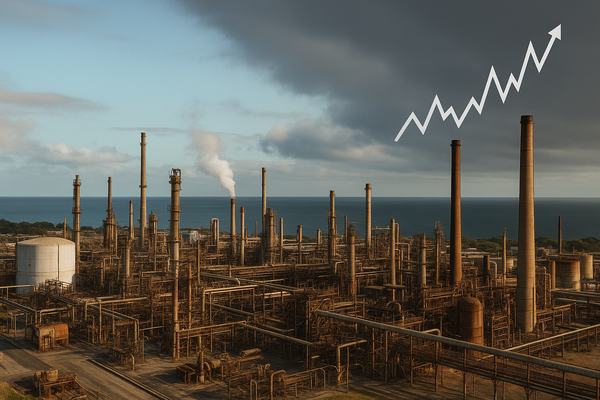
Alcoa to Close Kwinana Refinery. Alcoa (NYSE:AA) said in late September 2025 it will permanently close its Kwinana alumina refinery in Western Australia. The stock jumped 6.2% on the announcement as investors digested lost refining capacity and near-term cost relief. Short term, the move removes a regional supply outlet and concentrates adjustment costs in local operations. Long term, the closure tightens global refining capacity and could lift input prices for aluminium producers in the US, Europe and Asia if demand remains steady. Similar capacity exits in prior cycles tightened margins for smelters; the timing makes this development immediately market-relevant.
Immediate market reaction and company metrics
Shares of Alcoa (NYSE:AA) climbed 6.2% on the news, signaling investor relief about the company’s decision after a production curtailment and a comprehensive review of the plant’s economics. The announcement follows Alcoa’s broader cost-control narrative and sits alongside regional headlines. Trading volume stepped up on the move, reflecting heightened attention from both domestic Australian stakeholders and international commodity investors.
Meanwhile, the materials complex showed diverse responses. Dow Inc. (NYSE:DOW) slumped in recent trade, closing at $20.65 in the latest session, a decline of 6.48% from the prior day, even as it declared a quarterly dividend of $0.35 per share payable Dec. 12, 2025 with a record date of Nov. 28. Investors reacted to earnings and macro headlines unevenly, lifting some miners while pressuring diversified chemical names.
Supply implications across metals markets
The permanent loss of Kwinana lowers global alumina refining capacity and tightens the supply chain for smelters that rely on Australian and regional supply. That matters because refiners and smelters operate on thin margins where incremental capacity changes can swing input costs.
Precious and base metals have already seen strong momentum. Southern Copper (NYSE:SCCO) surged more than 22% in the past month, reflecting renewed investor appetite for resource producers with stable cash returns. Cleveland-Cliffs (NYSE:CLF) also posted notable strength, rising about 16% over the same recent period. These moves show how tightening supply or geopolitical headlines can concentrate flows into producers with direct commodity exposure.
Investor flows into specialty and strategic materials
Political and trade developments have pushed capital into strategic materials. MP Materials (NYSE:MP) featured heavily in coverage after tariff-related headlines on rare earths, and Western rare-earth names saw bouts of activity as investors priced potential supply diversification. The broader market backdrop was volatile; the S&P 500 recorded two new highs last week but ended with a sharp Friday selloff, underscoring rotation between growth and resource plays.
Rotation shows up in corporate returns too. Ardagh Metal Packaging (NYSE:AMBP) posted a one-year total shareholder return of 10.7% and a year-to-date price gain of 23.6%, though the stock eased about 7.6% in its latest pullback. Reliance Steel & Aluminum (NYSE:RS) has cooled from earlier strength, closing recently at $279.33 and sliding nearly 15% over the past three months, while its 12‑month total shareholder return stands at roughly -0.9%.
Catalysts to watch and what they mean for markets
Several near-term events will help determine whether commodity and materials volatility persists. Agnico Eagle Mines (NYSE:AEM) arrives with a busy schedule: Raymond James and CIBC both maintained Outperform ratings, and company commentary pointed to record free cash flow and disciplined costs ahead of Q3 earnings. Watch trading volumes and guidance language when AEM posts results; management tone will matter more than headline beats or misses.
Newmont (NYSE:NEM) also warrants attention. The consensus analyst price target recently rose from $79.64 to $88.91, reflecting upgraded expectations after asset optimization and new project milestones such as the Ahafo North first pour. That upward revision signals that analysts are re-pricing growth into valuations, which in turn affects sector multiples.
Other scheduled items include Silgan’s (SLGN) Q3 release on Oct. 29, 2025, and Vulcan Materials (NYSE:VMC) paying a quarterly dividend of $0.49 on Nov. 25, 2025, to holders of record Nov. 10. These corporate dates create pockets of liquidity that can amplify sector moves when macro headlines hit.
Scenarios and investor implications (informational)
If alumina availability tightens further, smelters could face upward pressure on feedstock costs, supporting margins for refined-product producers and certain miners. Conversely, if alternative supply routes or restarts offset Kwinana’s exit, pricing effects could be muted. Historical precedent shows that closures in refining networks can produce sustained unit-cost dispersion for several quarters.
For portfolio flows, watch which companies report sustained free cash flow and maintain dividends. Dow’s dividend of $0.35 and Vulcan’s $0.49 offer steady income cues; Newmont’s target uptick to $88.91 signals analyst willingness to re-rate producers on execution. Traders should monitor volumes and price spreads across aluminium, copper, and rare-earth-linked names for signs of broader repositioning.
Disclosure: This article is informational. It does not provide investment advice or make recommendations.












